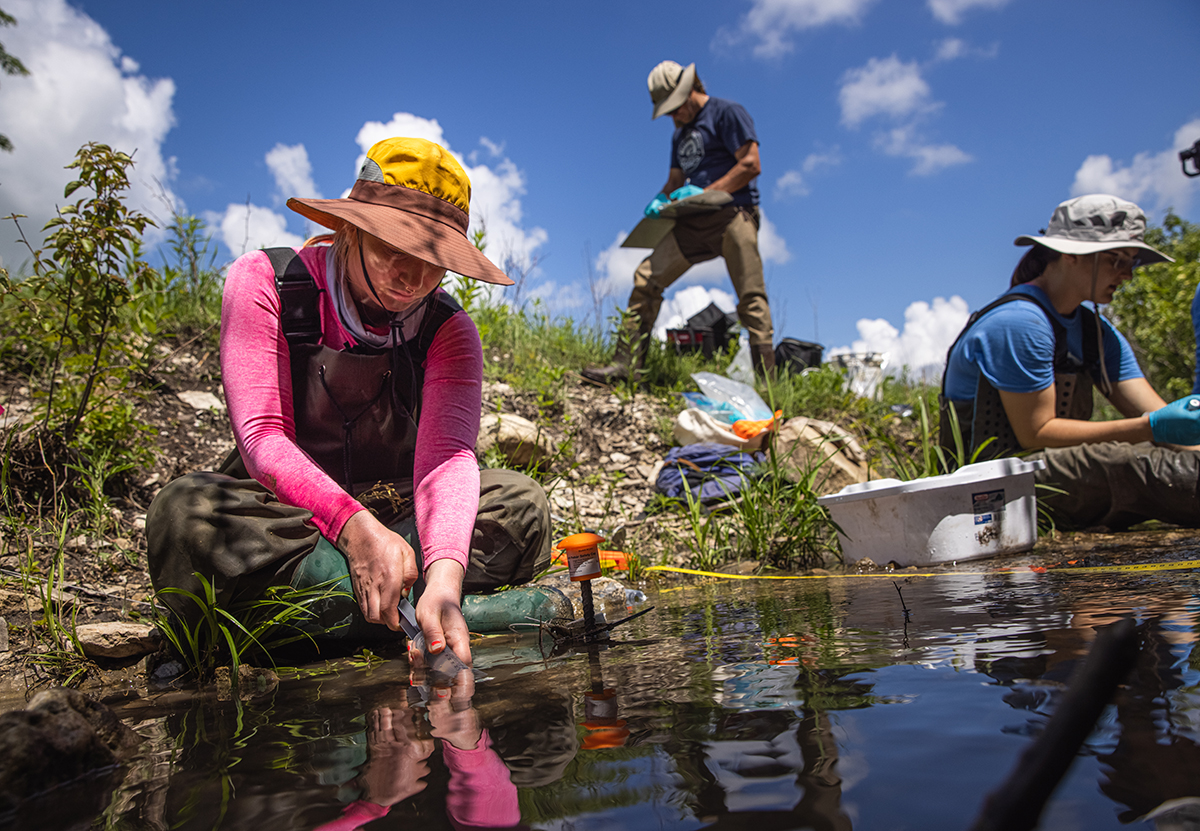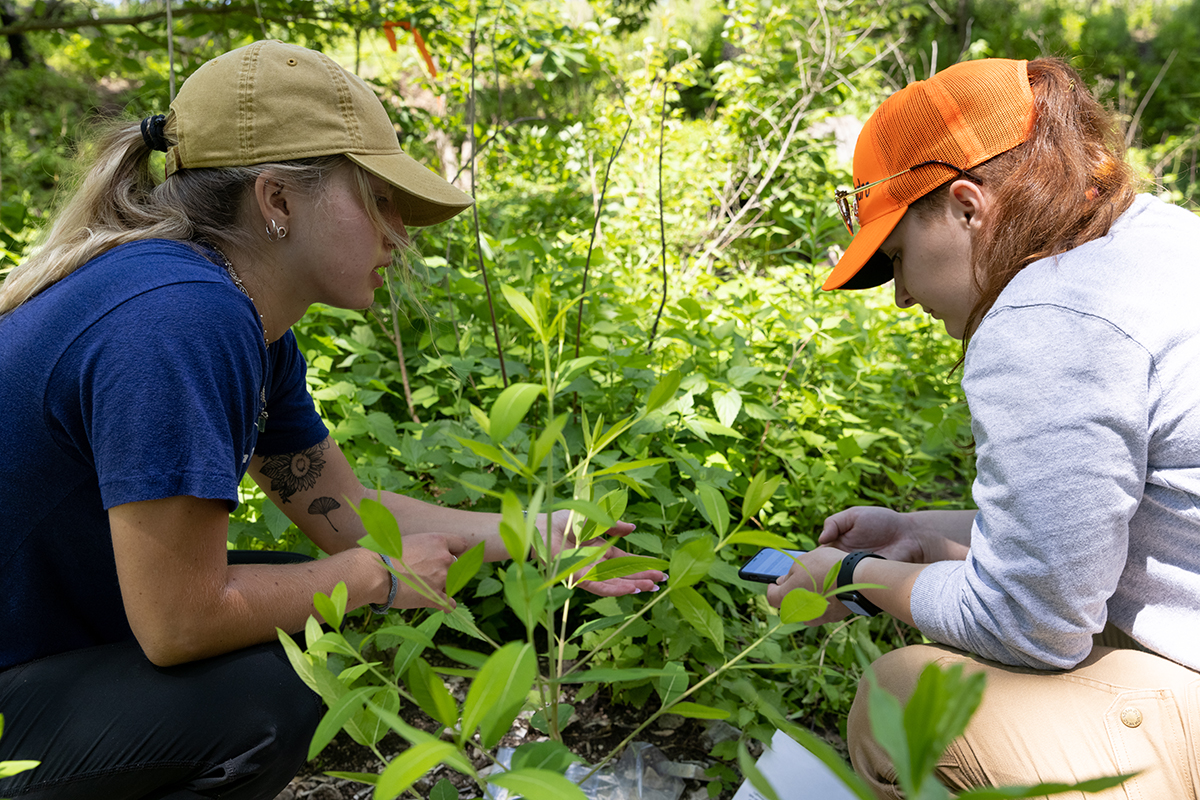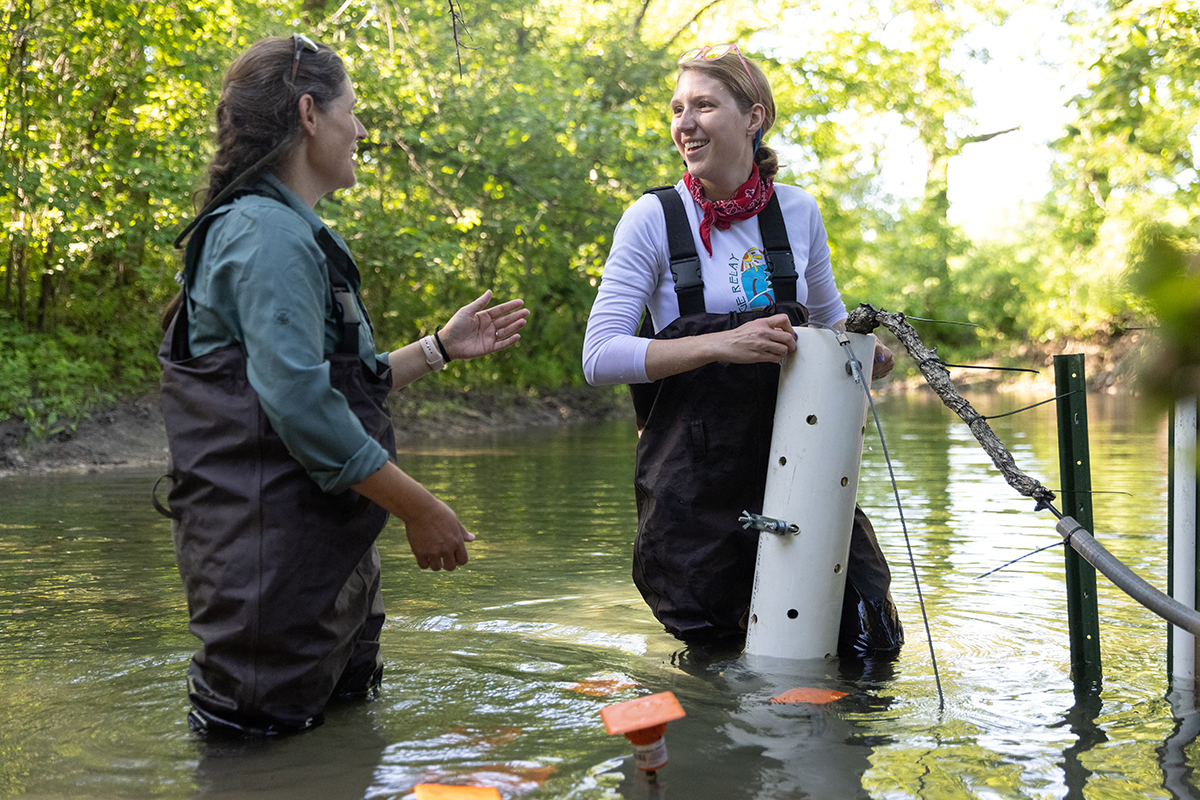#KUFieldWorks: Studying intermittent streams in the Konza Prairie
Editor’s note: Fieldwork provides invaluable insights about real-world environments and processes, expanding and reinforcing what researchers learn in classrooms, labs and collections. KU faculty, staff and students across a spectrum of disciplines are taking their inquiry directly to rivers, prairies, dig sites, glaciers, islands, burial grounds and more. Through the #KUFieldWorks series, we'll join them on their adventures.
Q&A with faculty and students in KU’s environmental studies + ecology and evolutionary biology programs
University of Kansas environmental studies and ecology & evolutionary biology students conducted fieldwork in the Konza Prairie this summer to understand the role of intermittent streams in controlling water quality and chemistry.
The lab of Amy Burgin, who is both an associate professor of environmental studies and ecology & evolutionary biology and an associate scientist with the Kansas Biological Survey & Center for Ecological Research, conducted the research. The work involved undergraduate and graduate student researchers, including senior Kaci Zarek (environmental studies) and Ph.D. aspirant Sarah Flynn (ecology & evolutionary biology). The lab also collaborated with Kansas Geological Survey scientists and faculty and students from other universities.
The team specifically studied Kings Creek, which is a fifth-order (or medium-sized) intermittent stream — meaning it sometimes dries out and drains the tallgrass prairie in the Kansas Flint Hills.
The study will inform understanding of intermittent streams, which are essential sources of drinking water, in Kansas and across the world.
What methods, approaches, experiments, etc. are you using?
Our approach is to conduct field observations, laboratory analysis, and modeling to understand hydrological, biological, and chemical controls of intermittent streams.
For this project, we collect samples to analyze for water chemistry, bugs, microbes and tracers between the ground and surface water. For this effort, we did a coordinated campaign at 50 sites in the Konza Prairie. We did this with 37 people from seven institutions, which allowed us to collect over 1,000 samples in about a week.
Why does your study matter to your field or for society?
Our study seeks to explore the interacting effects of hydrology, biogeochemistry, and microbial communities in intermittent streams, filling fundamental gaps in a critically understudied component of the Earth’s system.
Many people in Kansas and around the world rely on intermittent streams for drinking water, and we hope our research informs and empowers policymakers to keep that water healthy.
What do you enjoy most about being in the field?
Kaci: I enjoy being surrounded by streams and trees and away from my computer for the days I am in the field. It is so refreshing to be in the outdoors, but I also love being in the field because I get to collect my samples that will soon turn into data and results, which is so exciting!
Sarah: I enjoy seeing firsthand the ecosystem that I am attempting to learn about and protect. Being surrounded by the wildflowers, feeling the sun on my face, and hearing the flowing stream keeps me motivated to continue learning.
Amy: I enjoy the unstructured conversations with students and colleagues. I love the creativity and spontaneity of new ideas that can come out of field trips. I also really enjoy not checking my email for a day.

What are some memorable (funny, scary, surprising, etc.) moments from the field?
Kaci: One of the most memorable moments I had in the field was when I did a 24-hour diel sampling in the Konza Prairie. I was up until 3 a.m., and when we weren't sampling, I got to stargaze and enjoy the beauty of the calm night at Konza with minimal light pollution and no other humans around for miles — besides the field crew. Plus, I got to watch the sunset and sunrise at Konza, which was truly breathtaking and a memory I will cherish for a long time.
Sarah: The most memorable moments in the field normally occur after the fieldwork, when myself and all my colleagues can sit around a pile of snacks, talk science, and enjoy one another's company.
Amy: This particular trip went amazingly well — no issues beyond our normal of things not working properly, losing tools, and too many ticks. We were really hot and found a makeshift plunge pool to sit in in our waders to cool off.

When is fieldwork frustrating, challenging or overwhelming?
Kaci: Fieldwork can be challenging when it is an extremely hot day in the field because we need to take more breaks — and the sun beating down on us is never fun. It can also be challenging when it is a very long day in the field because with fieldwork there is never truly an accurate ending time — it all comes down to when all our sites are visited and all samples are collected. However, even with the long days and hot temperatures, it is one of the best parts of research.
Sarah: Our current work involves the use of a lot of new technology. We are constantly troubleshooting and trying to figure out how to make our sensors work how they're supposed to. It's stressful knowing that our data depends on this technology, and that I need to learn how to make it work. However, when it does work, it is worth all the stress and time.
Amy: Fieldwork is unpredictable — we don’t know what problems we’re going to have to solve, what will break, what weather we’ll encounter or what time we’ll be done. Compound those issues, and it’s easy to get overwhelmed. But I often tell students that learning to roll with the punches is part of being a field scientist — and it helps you have a plan and be flexible when you need a new plan.
How does fieldwork complement the work you do elsewhere?
Sarah: In our current project, we are creating data from the work we do in the field. Without the fieldwork component, we have no new information to offer the scientific community and the world at large. Our fieldwork directly informs new discoveries.
Amy: The fieldwork is the foundation of any other work we do — we are first and foremost a field-based operation. We make our data, and that requires collecting samples, installing sensors and getting to know a field site.
Top photo:University of Kansas researchers conduct fieldwork in prairies, rivers, streams and mountains. The #KUFieldWorks series follows researchers on their fieldwork adventures.
Second photo: Left to right: Amy Burgin, associate professor of environmental studies and ecology & evolutionary biology and an associate scientist with the Kansas Biological Survey & Center for Ecological Research, and Erin Seybold, assistant scientist at the Kansas Geological Survey, conduct fieldwork research in a stream in the Konza Prairie.
Third photo: Left to right: Ecology & evolutionary biology Ph.D. aspirant Sarah Flynn; Ken Aho, associate professor of community ecology & statistics at Idaho State University; and environmental studies senior Kaci Zarek, collect samples from a stream in the Konza Prairie.
Fourth photo: Kansas Geological Survey intern Michelle Wolford, left, and Delaney Peterson, a Ph.D. student at The University of Alabama, conduct research in the Konza Prairie.
